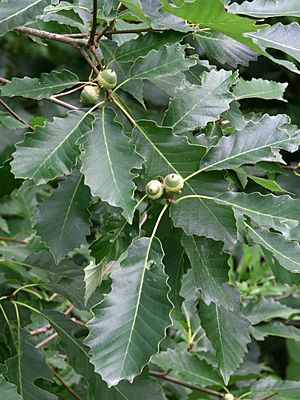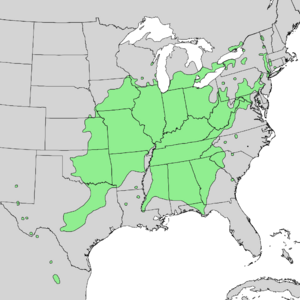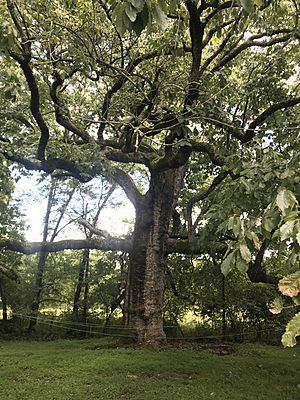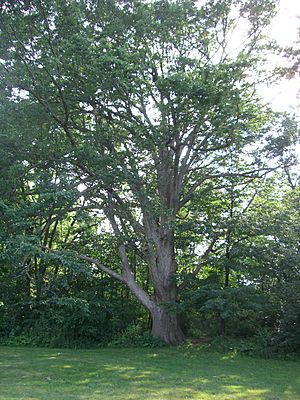Chinquapin facts for kids
Quick facts for kids Chinquapin |
|
|---|---|
 |
|
| Conservation status | |
| Scientific classification | |
| Genus: |
Quercus
|
| Species: |
muehlenbergii
|
 |
|
| Natural range | |
| Synonyms | |
|
List
Quercus muhlenbergii Engelm.
Quercus mühlenbergii Engelm. Quercus acuminata (Michx.) Sarg. Quercus acuminata var. alexanderiFarw. Quercus alexanderi Britton Quercus brayi Small Quercus castanea Muhl. Quercus castanea var. macrophylla Hampton Quercus muehlenbergii f. alexanderi (Britton) Trel. Quercus muehlenbergii var. alexanderi (Farw.) Farw. Quercus muehlenbergii var. brayi (Small) Sarg. Quercus prinoides var. acuminata (Michx.) Gleason Quercus prinoides f. alexanderi (Britton) Steyerm. Quercus prinus var. acuminata Michx. Quercus rubra var. muehlenbergii (Engelm.) Wenz. Quercus sentenelensis C.H.Mull. |
|
The Quercus muehlenbergii, often called the chinquapin oak or chinkapin oak, is a type of tree that loses its leaves every year (deciduous). It belongs to the white oak group. This tree is native to eastern and central North America. You can find it from Vermont to Minnesota, south to the Florida panhandle, and west to New Mexico in the United States. In Canada, it grows in southern Ontario. In Mexico, it ranges from Coahuila south to Hidalgo.
Contents
About the Chinquapin Oak Tree
Chinquapin oaks have both male and female flowers on the same tree. The flowers usually appear from April to early June. The male flowers grow in long, hanging clusters called catkins. The female flowers grow from the new leaves.
The tree's fruit is an acorn, which grows alone or in pairs. Acorns take one year to grow and are ready in September or October. About half of the acorn is covered by a thin cup. The acorns are chestnut brown to almost black.
How Chinquapin Oak is Different from Other Oaks
The chinquapin oak is similar to the smaller dwarf chinkapin oak (Quercus prinoides). Chinquapin oak is usually a tree, but sometimes it can be shrubby. Dwarf chinquapin oak is a low-growing shrub that spreads by making copies of itself (cloning). These two oaks usually grow in different places. Chinquapin oak prefers calcareous soils (soils with lots of lime) and rocky slopes. Dwarf chinquapin oak likes acidic soils, often sand or sandy soils.
Chinquapin oak can also be confused with the chestnut oak (Quercus montana). Here are some ways to tell them apart:
- Chinquapin oak leaves have pointed teeth. Chestnut oak leaves usually have rounded teeth.
- Chinquapin oak bark is gray and flaky, similar to white oak bark, but with a yellowish-brown color. This is why it's sometimes called "yellow oak."
- Chestnut oak bark is dark, solid, and has deep ridges.
- Chinquapin oak acorns are smaller than those of chestnut oak or swamp chestnut oak (Q. michauxii).
Key Features of Chinquapin Oak
Here are some important things to know about Quercus muehlenbergii:
- Its leaves usually have a rounded base.
- The veins and spaces (sinuses) on the leaves are regular.
- The acorns have no stalks or very short stalks (less than 8 mm long). They turn chestnut brown in the fall.
- The leaves have sharp teeth but no bristles. This shows it is part of the white oak group.
Naming the Chinquapin Oak

The scientific name Q. muehlenbergii honors Gotthilf Heinrich Ernst Muhlenberg (1753–1815). He was a pastor and a plant expert (botanist) in Pennsylvania. When George Engelmann named the tree, he accidentally used an umlaut (two dots) over the 'u' in Muhlenberg's name, writing Quercus mühlenbergii.
Today, plant naming rules say that umlauts like 'ü' should be changed to 'ue'. So, mühlenbergii became muehlenbergii. Even though the spelling muhlenbergii might seem more correct, muehlenbergii is the official scientific name.
The dwarf chinquapin oak (Quercus prinoides) looks similar to Q. muehlenbergii. For a while, people thought they might be the same species. But now, they are generally accepted as two different species.
Where Chinquapin Oak Lives
Soil and Land
Chinquapin oak usually grows in well-drained soils that come from limestone, or where limestone rocks stick out of the ground. Sometimes, it grows on well-drained limestone soils near streams. These trees prefer soils that are slightly acidic (around pH 6.5) to alkaline (above pH 7.0). They can grow on both north-facing and south-facing slopes, but they are more common on the warmer south-facing ones. You won't find them much at high elevations in the Appalachian Mountains.
Neighboring Trees and Plants
The chinquapin oak is rarely the most common tree in an area. But it grows with many other tree species. It is often found in forests with white oak (Quercus alba), black oak (Q. velutina), northern red oak (Q. rubra), and hickories (Carya spp.). Other trees it grows with include sugar maple (Acer saccharum), black cherry (Prunus serotina), white ash (Fraxinus americana), and black walnut (Juglans nigra).
Smaller trees and shrubs often found with chinquapin oak include flowering dogwood (Cornus florida), sassafras (Sassafras albidum), and sumacs (Rhus spp.). Common woody vines are wild grape (Vitis spp.) and greenbrier (Smilax spp.).
Dealing with Competition
Chinquapin oak does not like a lot of shade. It can handle some shade when it's young, but it needs more sunlight as it gets older. It is considered a "climax species" on dry, rocky soils, especially those from limestone. This means it's one of the main trees that will grow there over time.
Diseases and Pests
Strong wildfires can kill young chinquapin oaks. However, these trees often grow back from their roots. Fire scars can let in fungi that cause decay, which can harm the tree.
Oak wilt (Bretziella fagacearum) is a serious disease that attacks chinquapin oak. It usually kills the tree within two to four years. Other diseases include cankers and root rot.
Insects can also harm chinquapin oaks. Some insects, like the gypsy moth (Lymantria dispar), eat the leaves. Others, like the carpenterworm, bore into the tree's trunk, damaging the wood. Acorn weevils and moth larvae also feed on the acorns.
Uses of Chinquapin Oak
Like other white oak species, the wood of the chinquapin oak is very strong and lasting. It is used for many types of building and construction.
The chinquapin oak is especially known for its sweet and tasty acorns. The nuts inside their thin shells are among the sweetest of all oak acorns. They taste great even when eaten raw. These acorns are an excellent food source for many animals, including squirrels, mice, deer, and turkeys. People can also eat them.
See also
 In Spanish: Quercus muehlenbergii para niños
In Spanish: Quercus muehlenbergii para niños




